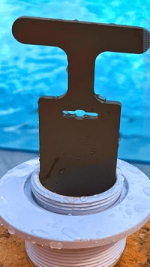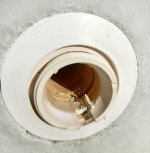My pool and spa were constructed in 1992 and we bought the property in 1996. Apart from pump, filter and valve replacements over the years, nothing else has been changed.
I suspect I have a small pressure leak in one of the two spa jet returns and plan on building a pressure test rig to check it out. I also think there is a suction leak on the spa drain so today, before buying test plugs, I decided to remove one of the eyeballs to check the pipe size and took some pictures.
I don't have any experience working on these so I'm not sure if these are 'normal' fittings by today's standards but I think I'm going to have a problem plugging the jets, due to the slots on either side. Is the outer threaded section supposed to be removed also and if so, should it just be pulled out? I did try gently pulling it but there was no movement and didn't want to force anything. The inner threaded section looks like it is keyed to fit in the slots
As far as I can tell, the inner threaded piece has an inner diameter of 1.5" but it may be difficult to insert a plug back there without removing the outer one. The narrow 'jet' sits about 3.25" back from the front of the outer threaded section.
I plan on replacing the two eyeballs in the spa plus the two in the pool and hope they will be compatible with what's there just now. One other thing I should mention is that I intend to have both the pool and spa resurfaced so if the return jets are required to be completely replaced, it would probably make sense to wait until then. Meanwhile, I would like to test for leaks and try to get those dealt with.
If anyone is familiar with this style of jet, I would welcome your comments and advice.
Regards,
Al
I suspect I have a small pressure leak in one of the two spa jet returns and plan on building a pressure test rig to check it out. I also think there is a suction leak on the spa drain so today, before buying test plugs, I decided to remove one of the eyeballs to check the pipe size and took some pictures.
I don't have any experience working on these so I'm not sure if these are 'normal' fittings by today's standards but I think I'm going to have a problem plugging the jets, due to the slots on either side. Is the outer threaded section supposed to be removed also and if so, should it just be pulled out? I did try gently pulling it but there was no movement and didn't want to force anything. The inner threaded section looks like it is keyed to fit in the slots
As far as I can tell, the inner threaded piece has an inner diameter of 1.5" but it may be difficult to insert a plug back there without removing the outer one. The narrow 'jet' sits about 3.25" back from the front of the outer threaded section.
I plan on replacing the two eyeballs in the spa plus the two in the pool and hope they will be compatible with what's there just now. One other thing I should mention is that I intend to have both the pool and spa resurfaced so if the return jets are required to be completely replaced, it would probably make sense to wait until then. Meanwhile, I would like to test for leaks and try to get those dealt with.
If anyone is familiar with this style of jet, I would welcome your comments and advice.
Regards,
Al



















